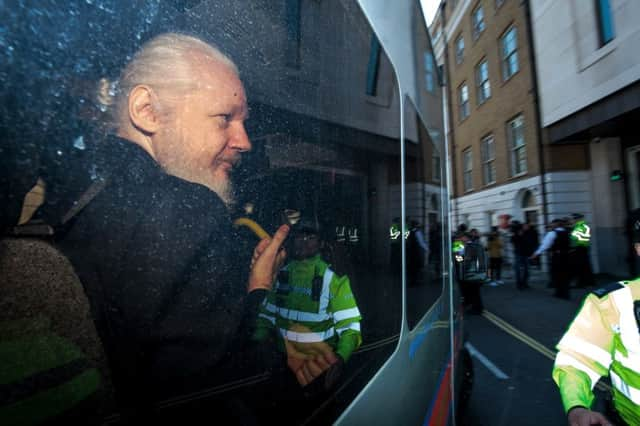Julian Assange arrested: Wikileaks founder faces life in US jail


Police detained the WikiLeaks founder after the Ecuadorian government withdrew his asylum, blaming his interference in international affairs and being discourteous to embassy staff.
The 47-year-old appeared at Westminster Magistrates’ Court yesterday and was found guilty of breaching his bail. He faces a jail sentence of up to 12 months when he is sentenced later at Crown Court.
Advertisement
Hide AdAdvertisement
Hide AdHe is also facing extradition to America on charges of conspiring to break into a classified government computer, a charge the US Department of Justice said could attract a maximum jail sentence of five years.
The US accuses Assange of assisting Chelsea Manning, a former US intelligence analyst, in breaking a password that helped her infiltrate Pentagon computers.
Assange was remanded in custody and will next appear at Westminster Magistrates’ Court on 2 May via prison video-link in relation to the extradition.
Scotland Yard said that Assange was held for failing to appear in court in June 2012 and “further arrested on behalf of the United States authorities, at 10.53am after his arrival at a central London police station”.
Assange, with his hair tied into a pony tail and sporting a long beard, was seen shouting and gesticulating as he was carried from the Ecuadorian embassy building in handcuffs by seven men and put into a waiting van shortly after 10am yesterday.
UK government ministers welcomed the move with both Home Secretary Sajid Javid and Foreign Secretary Jeremy Hunt tweeting that “no-one is above the law”.
But WikiLeaks said Ecuador had acted illegally in terminating Assange’s political asylum “in violation of international law”.
Assange, an Australian, came to prominence after WikiLeaks began releasing hundreds of thousands of classified US diplomatic cables.
Advertisement
Hide AdAdvertisement
Hide AdBut in 2010 an arrest warrant was issued for him for two separate allegations, one of rape and one of molestation, after he visited Sweden for a speaking trip.
Assange launched a legal battle against extradition to Sweden from the UK but when that failed he entered the embassy, requesting political asylum.
Assange refused to leave, claiming he would be extradited to the US for questioning over the activities of WikiLeaks if he did so.
The Ecuadorian government at the time was sympathetic to his cause but a regime change in 2017 heralded a less supportive approach and, after 2,487 days in the embassy building in the shadow of Harrods, he was finally removed.
In May 2017, Sweden’s top prosecutor dropped a long-running inquiry into a rape claim against Assange.
Earlier the Ecuadorian ambassador to Britain, Jaime Marchan, said that Assange was disrespectful, “continually a problem” and interfered in elections, politics and the internal affairs of other countries.
Officers detained Assange after the Ecuadorian government withdrew his asylum, blaming his “repeated violations” of “international conventions and daily-life protocols”.
“He was continually a problem to us,” Mr Marchan said.
